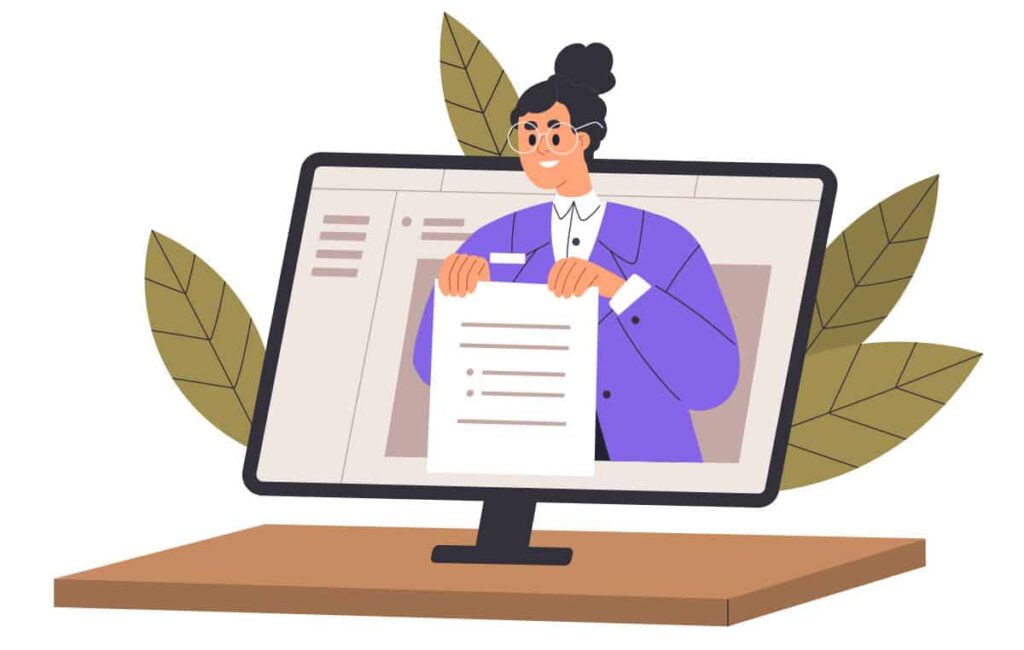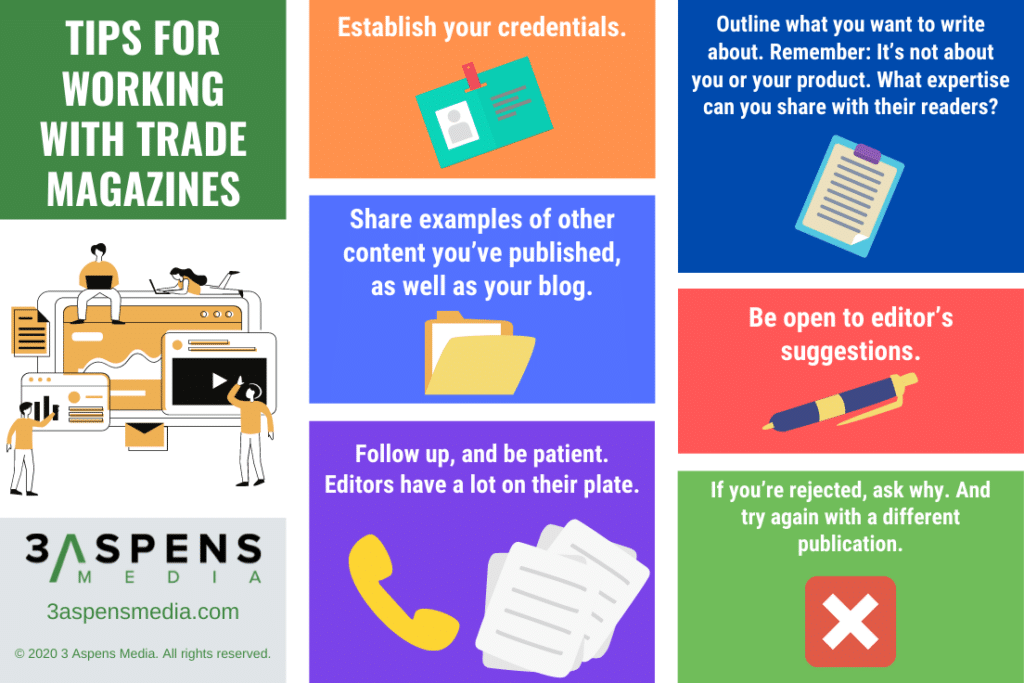Getting published in a trade publication as an expert in your field whether through your own articles or an interview with an editor can help you garner respect and establish your brand among prospects and customers.
But as a former editor, I’ve seen companies that do a great job working with editors of trade publications, and I’ve seen companies that fail miserably. If you’re looking to submit guest posts to trade publications as part of your content strategy, it helps to understand best practices.
Here, I answer some of the most frequently asked questions about getting published in B2B trade publications, informed by my own experience as well as our recent conversation with Mike Hockett, Executive Editor of Modern Distribution Management (MDM), and Natalie Forster, Chief Editor of Supply House Times.
What are trade publications?
Trade publications are typically focused on an industry niche. In the wholesale distribution space, there are publications that focus on general industrial distribution, such as Modern Distribution Management (MDM) and Industrial Distribution. There are also multiple publications that target companies in specific segments. For example, Supply House Times is a magazine and website that reaches plumbing supply distributors. Electrical Wholesaling targets the electrical channel – specifically electrical distributors and their channel partners.
There are examples of trade publications in every industry and publications that target specific Microsoft partners, and those that reach safety professionals. I frequent sites that target writers.
What does it mean to contribute to a trade magazine?
Some publications welcome and seek contributors to their websites and print publications (yes, print is still alive and effective). Many have policies on their websites that outline the kind of content they will accept (or if they will accept contributions from the outside at all). To get your piece placed in a highly targeted publication, you can either write a guest blog yourself or outsource ghostwriting services. Such a placement is also called content syndication.

Why should you get published in a trade magazine?
Getting published in a trade magazine through guest blogging can greatly expand your reach and boost the ROI of your content-creation efforts.
When you write for a trade publication, you reach the very audience you want to reach. It’s far more effective than going bigger with a Forbes or Inc. placement. Why? You know who is reading it. The numbers may be smaller, but if you target plant safety managers with your product or service, and they make up the primary audience of a trade publication, it’s hard to go wrong placing an article there.
Such placements also help you establish your expertise through a respected third party. And of course, provided you include a link back to your website; the resulting backlink to your website is great for SEO.
Should you ghostwrite or write the article yourself?
Whether you hire a ghostwriter or write the article yourself depends on your comfort level and time available.

Ghostwriting is working with a professional writer to get your thoughts down on paper and in a form an editor will accept. We do this a lot at 3 Aspens Media. Our clients have a lot to say, and the experience to back it up. But they may not feel comfortable with their ability to translate their knowledge and expertise into an article. Or they just simply don’t have time. Here’s how we write blogs for our clients so they don’t have to.
If you’re writing an article yourself and you’re confident in your skills (which is great!), you can submit it straight to the editor. You could also have the article edited by a professional editor.
💡 Bonus Tip: Think you don’t have time to write an article for a trade publication? Try repurposing your own content. Take a topic you’ve already written about and reframe it in a guest post for a publication. The ideas are there; you’re just changing how they’re presented and adding meat here and there to flesh it out. It’s easier than starting from scratch. For example, say you’ve written an article on best practices in ERP implementation. You could:
- Take a section of an article – say, the importance of buy-in by your team – and expand on that in a guest post.
- Reframe the article by reorganizing in a “tips” fashion – say, “3 tips for ensuring ERP implementation success.”
What should you write about for a trade publication?
When you’re writing articles for trade magazines or publications, apply the same philosophy you follow for your own blog. Ask yourself: What does that magazine audience care about? What are their pain points?
An editor will love you if you provide real solutions and ideas for their readers. Remember: It’s not about you.
“We like to publish well-written contributed content that educates our audience on topics we know are relevant to them,” says Mike Hockett, Executive Editor of MDM. “Publishing good contributed content shows we are connected with those experts working with distributors day in and day out. It positions us as a resource for good educational content in distribution.”
Think about the editor’s job. It’s not to publish your marketing pitch. If you send them a guest post that is nothing but an ad for your service, they’ll never publish it. Think beyond that: You have expertise that will benefit the reader. For example, if you sell CRM software, focus on best practices in implementation, something every company struggles with, or the importance of qualifying leads. If you offer services to clean sumps at machine shops, write about the impact of cleanliness on machine tool performance. But don’t bring in your specific offering.
As a general rule, leave your product out of it.
If you consistently give editors content that feeds their goal of providing useful information to their readers, they’ll reach out again down the road. Be helpful first and foremost.
“First and foremost, be educational,” says Natalie Forster, Chief Editor of Supply House Times. “We’re trying to educate our readers. Every single article, no matter who the author is, that’s our goal. The second most important thing is to know who my audience is. Look at the content I’ve published before, look at other contributed articles I have used, and understand who my audience is.”
💡 Bonus tip: Follow relevant trade publications on social media channels and sign up for their newsletters to not only support them and gain insights on your own markets, but also to get a better feel for the type of content that they publish.
How do you connect with a trade publication editor?
If you want to better understand what a publication is interested in, simply reach out to the editor and ask. Most are happy to have a short conversation about gaps they have in coverage. This also gives you an opportunity to tell them which topics you can provide insight on. (That said, don’t spend the call asking how you can “get coverage” for your product.)
“My two favorite types of emails to get are ones that ask what our audience wants to hear about and people who have done their research and sent me a bullet list of three things they are ready to write about,” Forster says.
“I get emails all the time asking, ‘Can you give us two or three trending topics you would like to see more content on?’” Hockett says. “It can never hurt to ask an editor that question.”

If you have a specific pitch you’d like to make for a topic, send them a simple email, referencing some of the coverage they’ve already had on the topic:
- Establish your credentials.
- Outline what you’d like to write about. Be open to their suggestions for an angle.
- Share examples of other pieces of content you’ve published elsewhere or on your site.
- Follow up. But don’t be annoying. If an editor is in the middle of a deadline (which happens frequently) they won’t have time to reply to you. Still, it’s OK to make sure your pitch didn’t fall through the cracks.
If they reject your pitch, they usually have a good reason. Ask for it, and be receptive to other approaches to that topic. And just because they rejected your idea, that doesn’t mean another editor won’t embrace it. Keep trying.
How do you improve an article’s chances of being accepted by an editor?
Hockett and Forster had a lot to say about the dos, don’ts and best practices of writing articles editors will not only accept but appreciate and anticipate.
Be educational for the audience. “They should learn something from it,” Hockett says. “Especially in the introduction section of the article. That’s where you want to demonstrate, ‘Here’s the value you’re going to get out of reading this article.’”
Get to know the audience first. Each trade publication has its own unique audience, and editors are excellent gatekeepers who know what serves their audiences. Be sure to research who you’re talking to through each publication so you’re pitching the right content to the right editor.
Don’t use promotional language. With guest blogging, you’re not angling for direct leads. You’re establishing yourself as a thought leader and resource. At this stage in the funnel, your bio and company name associated with the article will be sufficient. Avoid mentioning your company or product unless it adds value to the article.
“If (the contributor is) using it as an example that effectively illustrates a point being made, we will allow it,” Hockett says. “But if they’re just name dropping their company or plugging their product, then it’s a no go.”
Provide fresh content and a fresh take. Be aware of other recent articles they’re publishing, so you’re not sending redundant topics their way. “Do a little bit of research,” Forster says. “Have I done an article like that before? What’s your new take on it?”
Be open to edits and suggestions. Editors will likely tweak your article to fit their preferred style and optimize it for their audience and the medium itself. For instance, they might make the headline snappier or integrate SEO into the introductory paragraphs. For the most part, they’re simply looking to make their content consistent and useful for their audience.
Don’t let grammar and structure hold you back. “There are contributors who admit they are not natural writers,” Hockett says. “They’ll let us know they’re much better at articulating in an oral fashion than in writing. The same goes for contributors for whom English might not be their first language. For authors for whom English isn’t their first language, there might be some editing involved in there, but as long as the meat of the article is there, it’s good to go.”
Forster agrees, saying: “If I get an article that doesn’t match style, but if it’s content that helps my audience, I don’t mind taking the time to technically edit it.”
Check out our video panel discussion with Hockett and Forster for more insights directly from the editors:
What if my phone doesn’t ring off the hook after I’m published?
It might not. In fact, it probably won’t after the first one unless you’ve hit a nerve for a reader. More frequently, I hear that phones ring after several placements. Prospects who reach out will tell our clients they have seen them published “everywhere” and want to talk with them about their particular challenge with that topic. And thus, the door opens. But just as with any form of content marketing, it takes time. This type of content is top-of-the-funnel; it’s not designed to convert. It’s designed to raise brand awareness; establish your credibility in the market; and keep you top of mind when a prospect does have a problem they think you could solve.

Bonus Question: What about getting my press releases published?
Every publication is different. One publication may care about you tapping a new sales manager, and another won’t. Some care about a new product launch and others don’t. Some care about your new website; some don’t. It all depends on the type of publication you’re working with. That doesn’t mean you shouldn’t send the press releases.
Keeping your company’s name in front of editors is a good way to get them to think of you if a topic comes up they think you can speak to. As an editor, I regularly filed away releases I had no intention of publishing because I knew the company could be a good source one day. So, send away, but don’t get frustrated if they don’t publish it, or, if they do publish it, it’s hidden away. It’s still worth your time.
I’d love to hear what you’re doing that’s working or the challenges you’re facing getting published. Reach out to me at lindsay@3aspensmedia.com.



